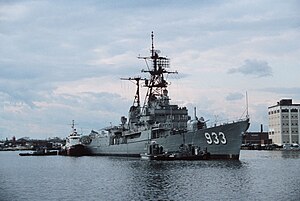 USS Barry on 16 October 1983
| |
| Class overview | |
|---|---|
| Name | Forrest Sherman class |
| Builders | |
| Operators | |
| Preceded by | Mitscher class |
| Succeeded by | Farragut class |
| Built | 1953–1959 |
| In commission | 1955–1988 |
| Completed | 18 |
| Retired | 18 |
| Preserved | |
| General characteristics | |
| Type | Destroyer |
| Displacement |
|
| Length |
|
| Beam | 45 ft (14 m) |
| Draft | 22 ft (6.7 m) |
| Propulsion |
|
| Speed | 32.5 knots (60.2 km/h; 37.4 mph) |
| Range | 4,500 nautical miles (8,300 km) at 20 knots (37 km/h) |
| Complement | 15 officers, 318 enlisted |
| Sensors and processing systems | Mark 56 fire-control system |
| Armament |
|
The 18 Forrest Sherman-class destroyers comprised the first post-war class of US destroyers. Commissioned beginning in 1955, these ships served until the late 1980s. Their weaponry underwent considerable modification during their years of service. Four were converted to guided-missile destroyers. This class also served as the basis for the Charles F. Adams-class guided-missile destroyers.
Two ships of the class became museum ships, nine were sunk in training exercises, and the others were scrapped.